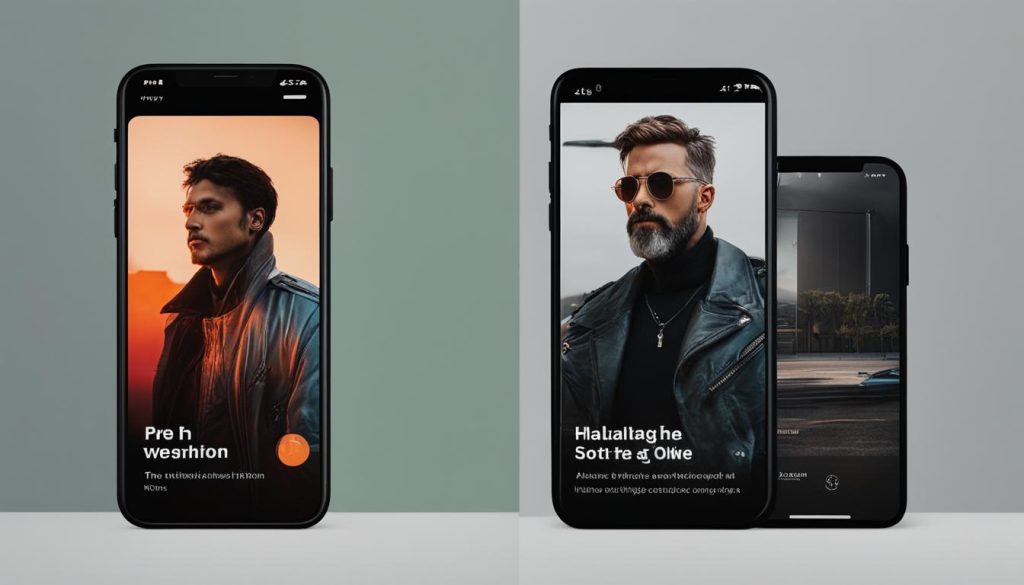Navigating the ever-evolving world of Instagram means understanding how the platform’s features can best serve your business’s unique voice and goals. The debate of Instagram post vs story often surfaces for marketers and content creators alike, seeking to amplify their brand in the digital space.
In analyzing the difference between Instagram post and story, it’s clear that each serves its distinct purpose. An Instagram post offers permanency, enhancing your profile with a collection of evergreen visuals that reflect your brand’s essence. However, the benefits of using Instagram stories include engaging followers through fleeting, casual snapshots of your day-to-day business life, inviting immediate interaction and enriching your brand’s narrative with a sense of urgency and authenticity.
Given the dynamic and competitive nature of online branding, recognizing when to use either an Instagram post or story for business becomes crucial. To navigate this with precision, the insights from Instagram post vs story analytics can empower your strategic decisions, leading to more targeted and effective engagements with your audience.
Key Takeaways
- Understanding the unique functions of Instagram posts and stories is essential for strategic content planning.
- Permanent Instagram posts are ideal for evergreen content that aligns with your brand image.
- Instagram stories harness the power of immediacy and interactivity to deepen real-time user engagement.
- Combining posts and stories can create a complementary strategy for greater reach and impact.
- Analyzing Instagram post vs story analytics informs which format resonates more with your audience.
The Unique Purposes of Instagram Posts and Stories
When it comes to creating a robust Instagram presence, understanding the role of posts and stories is crucial for brands aiming to maximize their impact on the platform. While posts often act as the cornerstone of lasting content, stories provide dynamic and ephemeral connections with audiences. Employing both effectively demands a strategic approach that plays to their respective strengths.
Evergreen Content vs Ephemeral Updates
Posts are the bedrock of evergreen content, standing the test of time and continually catching the eyes of new and existing followers. They serve as pillars for promoting products, where sustainability in viewer engagement is desired. Conversely, stories are synonymous with ephemeral updates—fleeting yet powerful interactions that capture the immediacy of a moment, ideal for time-sensitive announcements or spontaneous user engagement.
Curated Brand Images vs Real-Time Engagement
Creating an aesthetically pleasing Instagram feed with curated posts establishes a brand’s visual identity and longevity. The harmonious blend of images and video posts presents a polished brand image that invites long-term followership. In contrast, Instagram stories excel at real-time engagement, allowing followers to feel connected to the brand in the now, fostering a relationship built on the currency of the moment.
Creating a Cohesive Profile with Posts
The art of crafting engaging Instagram posts lies in their ability to generate a cohesive narrative. High-quality visuals and rich narratives build a profile that both informs and intrigues. Through deliberate postings, a brand can weave a comprehensive story that resonates deeply, fortifying its market position with each frame.
The Immediate Impact of Stories
For immediate brand-consumer interactions, nothing beats Instagram stories. With powerful, time-sensitive content like live events or special offers, stories invoke a sense of urgency and inclusion. The interactive nature of Instagram stories demands attention and calls for audience participation, proving indispensable for promoting products with direct calls-to-action that drive prompt responses.
In essence, utilizing Instagram’s dual formats is a nuanced dance between consistency and spontaneity, between polished narratives and raw immediacy. Brands that master this dance, tailoring their use of posts for comprehensive storytelling and stories for instant connection, thrive in the ever-evolving social landscape.
Dissecting the Anatomy of Instagram Posts and Stories
To grasp the efficacy of your social media efforts, it’s critical to recognize when to use an Instagram post vs story. Your strategy hinges on understanding the core elements and benefits of using Instagram stories versus posts. While an Instagram post is the bedrock for evergreen content, a story adds a layer of urgency and engagement, both of which are measurable through Instagram post vs story analytics. Let’s explore the integral features of each to better inform your content strategy.

| Feature | Instagram Post | Instagram Story |
|---|---|---|
| Content Type | Photos, Videos, Carousels | Photos, Short Videos, Text, Stickers, Polls |
| Orientation | Square or Landscape | Vertical |
| Permanence | Permanent on Profile | Disappear after 24 hours or added to Highlights |
| Character Limit | Up to 2,200 Characters | N/A, 15 seconds per clip |
| Interactivity | Likes, Comments, Shares | DMs, Polls, Swipe-ups, Quick Reactions |
| Analytics | Engagement, Reach, Likes, Comments | Views, Replies, Exit Rates, Navigation |
The table above provides a clear visual aid in distinguishing between a post and a story. Acknowledging these distinctions will maximize your entity’s presence on Instagram and allow for a well-rounded approach to engaging with your audience. Remember, the timing, format, and impermanence of stories can be an excellent tool for momentary marketing captures, while posts add to a narrative that builds your brand’s legacy.
Instagram Post vs Story: Crafting Content Strategies
Understanding the dynamic capabilities of Instagram for business is crucial when developing a content strategy. By recognizing the distinctive advantages of both Instagram posts and stories, companies can forge a robust online presence that resonates with their target audience. Let’s explore how these two forms of content can be harnessed to build meaningful connections, spur immediate user action, and guide analytics-driven marketing strategies.
Establishing Deeper Connections Through Posts
Instagram posts are the cornerstone of long-term brand building. With their ability to remain visible on your profile indefinitely, they house the more polished facets of your branding narrative. Posts are the digital equivalent of a carefully curated gallery, allowing for an in-depth portrayal of products, sharing comprehensive messages, and gradually nurturing customer relationships.
Leveraging Stories for Immediate Engagement
The transient nature of Instagram stories makes them a powerhouse for immediate engagement. They are a marketing maven’s dream for promoting time-sensitive events, such as flash sales or new product launches. With features like instant polls and swipe-up links, stories don’t just inform — they invite interaction, fostering a two-way conversation between brand and consumer.
Incorporating Analytics for Strategic Decisions
Fusing creativity with data analysis allows businesses to refine their Instagram strategies continuously. By examining insights from Instagram post vs story analytics, marketers can discern preferences, measure the impact of their content, and adapt their strategies to maximize the engagement and reach of their campaigns.
Creative Approaches with Posts and Stories
Integrating the best practices for using Instagram posts and stories, brands can craft content that transcends the conventional. It’s about storytelling with a twist, where posts map the journey and stories bring the real-time excitement, each format complementing the other to promote products and elevate brand visibility.
Ultimately, the art of promoting products through Instagram posts vs stories hinges on a brand’s ability to offer a cohesive and engaging experience. By tailoring content to serve different but complementary purposes, businesses can engage their audience on multiple levels — establishing endearing connections via posts while driving spontaneous engagement through stories.
Promoting Products through Instagram Posts vs Stories
When it comes to promoting products through Instagram, it’s crucial to understand the unique advantages of posts and stories. Savvy marketers know that how to create engaging Instagram posts can differ significantly from the approach to tips for making interactive Instagram stories. Posts are the go-to for presenting products in detail, utilizing crisp visuals and compelling captions, thereby building a narrative over time that contributes to a brand’s digital footprint and SEO.
On the other side of the spectrum, Instagram stories offer a more spontaneous and engaging experience. Their fleeting nature, enhanced with features like polls and direct links, is perfect for creating a sense of urgency around time-sensitive promos or exclusive sneak peeks. This transient yet impactful format captures audience attention through the fear of missing out (FOMO), potentially boosting immediate traffic and sales.

- Posts: Use for detailed product representation, sustained brand storytelling, and high-quality images.
- Stories: Ideal for flash sales, event promotion, or user engagement through polls and interactive elements.
Leveraging both posts and stories allows for a strategic promotional mix that can maximize brand visibility and engagement. Incorporating the right hashtags and location tags can amplify reach, while thoughtfully curated stories can be highlighted to preserve key moments beyond the standard 24-hour period.
In summary, whether opting for a post or story, the content should be carefully crafted to meet your promotional objectives, using each medium’s strengths to foster brand affinity and a dynamic online presence.
Conclusion
As we delve into the intricacies of Instagram’s dual offerings, it becomes clear that understanding the difference between Instagram post and story is pivotal for crafting a comprehensive social media strategy. The sophistication of Instagram for business lies in the artful balancing act between the evergreen nature of posts and the ephemeral charm of stories. Each plays a crucial role in brand storytelling and audience engagement, complementing the other to build a rich, multifaceted online presence.
Best Practices for Balancing Posts and Stories
Employing the best practices for balancing posts and stories involves a rigorous analysis of content performance. Instagram post vs story analytics provide the insights necessary for marketers to pinpoint when a post may outshine a story, and vice versa, adapting to audience behavior. Utilizing posts for their longevity and leveraging stories for their spontaneous flair allows brands to maintain both relevance and reliability within their social media narrative.
Understanding Your Audience’s Preferences
Knowing when to deploy an Instagram post vs story hinges on an acute understanding of your target demographic. Audience preferences can widely vary, with certain groups gravitating more towards the polished presentation of posts, while others relish in the interactive, fleeting experiences offered by stories. Listening to the audience’s voice and tracking engagement metrics is instrumental in optimizing the content mix to better connect with your followers.
Instagram Post vs Story: Sustaining Business Growth Through Both Formats
Ultimately, the fusion of Instagram posts and stories paves the way for sustainable business growth. This duality enables businesses to cast a wider net—reaching new audiences with posts and engaging current followers with stories. In an ever-evolving digital landscape, a versatile approach to content cultivation is not just recommended; it is essential for those looking to thrive on Instagram, harnessing both formats to craft a social media legacy that is as enduring as it is dynamic.
FAQ
What is the difference between an Instagram post and a story?
An Instagram post is a permanent piece of content that appears on your profile and remains there indefinitely unless deleted. It can be a photo, video, or carousel and includes a caption, hashtags, and can be shared publically or privately. An Instagram story, on the other hand, is a temporary update that disappears after 24 hours unless saved to your Highlights. Stories can include photos, short videos, live videos, text, and interactive elements like polls or questions and are designed for more informal, real-time engagement with your audience.
Should my business use Instagram posts or stories?
Your business can benefit from using both Instagram posts and stories. Posts are ideal for sharing high-quality, evergreen content that contributes to your brand’s long-term narrative and discoverability. Stories are best for ephemeral, real-time content that encourages immediate engagement from your followers, such as flash sales or quick updates. The choice depends on the content and intended audience reaction. Combining the two strategically can effectively build your brand presence on Instagram.
What are the benefits of using Instagram stories?
Instagram stories allow for real-time engagement with your audience through interactive features like polls, questions, and the ‘Swipe Up’ option for accounts that have access to it. They’re perfect for conveying the human side of your brand with behind-the-scenes content, encouraging urgency with time-limited offers, and they can boost your content’s visibility since stories are prominently featured at the top of followers’ feeds.
How do Instagram post vs story analytics differ?
Instagram post analytics can provide insights such as likes, comments, saves, shares, reach, and impressions, which help you understand how your content is performing over a long period. Story analytics offer metrics like views, forwards, backwards, exits, and interactions, which inform you about the immediate engagement and how viewers are interacting with your stories within their 24-hour life span. By reviewing both, businesses can gauge the performance and impact of different content types and refine their strategies accordingly.
How can I create engaging Instagram posts?
To create engaging Instagram posts, focus on high-quality visuals and compelling captions that resonate with your audience. Use a consistent visual style to maintain a cohesive look on your profile. Include relevant hashtags to increase discoverability, and encourage user interaction by asking questions or prompting your audience to take action. Stories that showcase your brand’s personality, behind-the-scenes content, or interactive elements like polls and quizzes can help foster a connection with your followers.
What are some tips for making interactive Instagram stories?
To make your Instagram stories more interactive, incorporate features such as polls, question boxes, quizzes, and countdowns. Using stickers, GIFs, and music can also enhance the storytelling aspect. Encourage viewer action by using the ‘Swipe Up’ feature or asking followers to message you directly in response to your stories. Also, take advantage of stories for real-time engagement by going live or sharing spontaneous moments.
When should I use an Instagram post vs a story for promoting products?
Use Instagram posts to promote products when you want to share detailed information, showcase high-quality imagery, or build a narrative around your product that persists on your profile. Posts can help in driving long-term engagement and searchability. Conversely, use stories to highlight time-sensitive promotions, share quick product updates, or create urgency with limited-time offers. Stories are also effective for interactive product Q&As or to give a sneak peek of new arrivals.
What are the best practices for using Instagram posts and stories?
The best practices for using Instagram posts and stories involve understanding the unique advantages of each format. Create a content calendar that leverages the permanence of posts for consistent branding and the immediacy of stories for engagement. Monitor your analytics to see what works best, and don’t hesitate to adjust your approach. Engage with your audience in the comments of your posts and through direct messages from your stories to build a community around your brand.

Hey there, I’m Wesley! Passionate about all things social platforms, I founded this blog to decode the ever-changing landscape of likes and shares. If you’re looking to up your social game, you’re in the right place. Let’s make your feed something to talk about!




